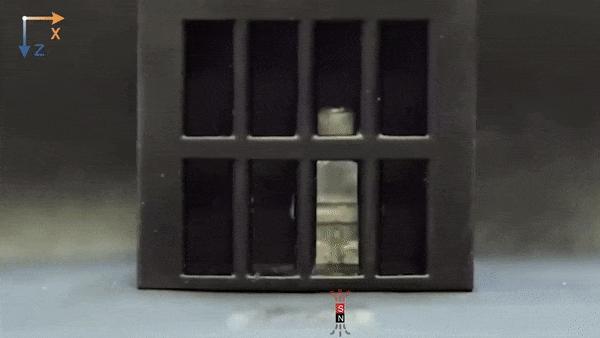New Research
Artificial Intelligence Identifies Long-Overlooked Raphael Masterpiece
A facial recognition analysis found that the faces in a mysterious painting are virtually identical to those in the artist's "Sistine Madonna"
This Shape-Shifting Robot Can Liquefy Itself and Reform
The technology could one day assemble and repair hard-to-reach circuits, act as a universal screw or retrieve foreign objects from a body, researchers say
What Secrets Lie Beneath This 17th-Century French Aristocrat's Smile?
New research suggests noblewoman Anne d’Alégre used gold wire to keep her decaying teeth in place
In Alaska, Hungry Wolves Have Started Eating Sea Otters
After devouring their island's deer, these canines may be the first land predators to rely on sea otters as a main food source
These Ants Were Trained to Sniff Out Cancer
In just ten minutes, an ant could learn to identify urine from mice with cancerous tumors, a new study finds
The Spin of Earth's Inner Core May Be Changing, Scientists Say
A new study finds our planet's iron center shifts between spinning slightly faster and slightly slower than the surface—but not all experts agree
Light Pollution Is Outshining Stars Faster Than Thought
The artificial glow threatens astronomy, migrating birds and human health
This 'Jousting' Trilobite Might Be the First Known Creature to Fight for a Mate
Using a “trident” attached to its head, the arthropod may have competed for sexual dominance 400 million years ago
Scientists Guide Lightning Bolts With Lasers for the First Time
The technology could one day protect wider areas than metal lightning rods do, perhaps shielding airports and launchpads during storms
Oceans Break Record for Highest Temperatures Four Years in a Row
Warming oceans can drive sea-level rise and extreme weather
Puget Sound's Parasites Are Disappearing—but Don’t Be Glad to Say Goodbye
The decline, which was correlated with warming waters in a new study, is bad news for ecosystems
See the Largest Known Flower Preserved in Amber
Aided by modern technology, researchers discovered the prehistoric blossom was a case of mistaken identity
Genetic Mutations Could Help Lizards Survive City Life
Urban Puerto Rican crested anoles show genetic changes related to immune function, metabolism and limb and skin development
See the Face of a Neolithic Man Who Lived in Jericho 9,500 Years Ago
Prehistoric people modified a skull to create a rudimentary likeness of its owner. Now, scholars have produced a more accurate facial reconstruction
'Self-Healing' Concrete May Have Preserved Ancient Roman Structures
The durable material could fill its own cracks, new research suggests
Could These Cave Markings Be the Earliest Form of Writing?
New research proposes that symbols in 20,000-year-old cave drawings are a proto-writing system, but not all scientists are convinced
Could Climate Impact Labels Change the Way We Eat?
Warnings on fast-food menus might make Americans think twice about choosing beef, a new study finds
More Kids Are Accidentally Eating Marijuana Edibles, Study Finds
Between 2017 and 2021, accidental cannabis ingestion in young children rose by 1,375 percent
These Frogs Turn Nearly Invisible While Sleeping
The transparent glass frog can hide 89 percent of its blood in its liver, new research shows
Unearthed Near Stonehenge, This Toolkit Was Used for Goldwork 4,000 Years Ago
The toolkit was discovered in 1801—but until recently, researchers didn't understand its purpose
Page 39 of 254
:focal(1926x1926:1927x1927)/https://tf-cmsv2-smithsonianmag-media.s3.amazonaws.com/filer_public/bf/34/bf341ac9-3e39-46b9-bd74-c5d2d95020c6/tondo.jpeg)

:focal(700x527:701x528)/https://tf-cmsv2-smithsonianmag-media.s3.amazonaws.com/filer_public/59/a8/59a874ad-2a96-4d77-a01f-287e03acb5a7/anne.png)
:focal(1800x1200:1801x1201)/https://tf-cmsv2-smithsonianmag-media.s3.amazonaws.com/filer_public/f9/f4/f9f4b756-281a-4af6-b3c7-bae637aff13d/gettyimages-1372797680_1.jpg)
:focal(512x385:513x386)/https://tf-cmsv2-smithsonianmag-media.s3.amazonaws.com/filer_public/f5/eb/f5ebe95c-8520-4f06-b973-447dcc3abf94/formica_fusca_01.jpeg)
:focal(3942x2252:3943x2253)/https://tf-cmsv2-smithsonianmag-media.s3.amazonaws.com/filer_public/91/82/918246b8-4e70-41c4-98ec-80319123fc77/gettyimages-1148113995.jpg)
:focal(2700x1800:2701x1801)/https://tf-cmsv2-smithsonianmag-media.s3.amazonaws.com/filer_public/70/26/7026e69d-489e-48b3-b5f1-782df0d11e13/gettyimages-1134057774.jpg)
:focal(2160x1625:2161x1626)/https://tf-cmsv2-smithsonianmag-media.s3.amazonaws.com/filer_public/18/ae/18ae4813-3126-4e60-b672-ccb189f4efce/walliserops_trifurcatus_jbel_gara_el_zguilma_draa_valley_morocco_-_houston_museum_of_natural_science_-_dsc02019.jpeg)
:focal(2412x1562:2413x1563)/https://tf-cmsv2-smithsonianmag-media.s3.amazonaws.com/filer_public/9b/95/9b95d7a9-da94-4f57-8db9-e7629c8f3941/gettyimages-1238658502.jpg)
:focal(2675x1758:2676x1759)/https://tf-cmsv2-smithsonianmag-media.s3.amazonaws.com/filer_public/ab/35/ab359638-6072-4084-aeb9-c0d50855fa51/gettyimages-1392464830.jpg)
:focal(1104x936:1105x937)/https://tf-cmsv2-smithsonianmag-media.s3.amazonaws.com/filer_public/cc/2b/cc2bf543-6daa-4f7d-b0a7-7fc2ffad37dd/parasitic_worms.jpg)
:focal(600x400:601x401)/https://tf-cmsv2-smithsonianmag-media.s3.amazonaws.com/filer_public/a7/19/a7192e01-a074-4cf1-a588-63927022cad6/bernstein_c_carola_radke.png)
:focal(310x233:311x234)/https://tf-cmsv2-smithsonianmag-media.s3.amazonaws.com/filer_public/ec/d4/ecd4b88d-bb84-4ddd-8793-89396f2f81a4/1673294693428.jpg)
:focal(573x453:574x454)/https://tf-cmsv2-smithsonianmag-media.s3.amazonaws.com/filer_public/a8/59/a8590281-f989-4047-bdb4-2a18d0806882/jericho.png)
:focal(2144x1368:2145x1369)/https://tf-cmsv2-smithsonianmag-media.s3.amazonaws.com/filer_public/ce/0b/ce0bc892-278d-4582-a2c0-e960d2c254e4/gettyimages-1377556481.jpg)
:focal(400x301:401x302)/https://tf-cmsv2-smithsonianmag-media.s3.amazonaws.com/filer_public/93/c2/93c279eb-945c-4ece-a344-1450646902f4/lascaux_004_800_x_600.jpg)
:focal(1061x707:1062x708)/https://tf-cmsv2-smithsonianmag-media.s3.amazonaws.com/filer_public/e5/36/e536e502-20c8-4cfe-bab0-7573c1788f98/gettyimages-157437054.jpg)
:focal(1060x707:1061x708)/https://tf-cmsv2-smithsonianmag-media.s3.amazonaws.com/filer_public/c6/94/c6945adf-cb8b-43f8-93e9-6748103510b1/gettyimages-1271218024.jpg)
:focal(610x346:611x347)/https://tf-cmsv2-smithsonianmag-media.s3.amazonaws.com/filer_public/48/28/4828a1dc-0aee-44c6-bcc7-df5ebf88eea4/glassfrogs-transparent-1400-788_full_1220.jpg)
:focal(792x433:793x434)/https://tf-cmsv2-smithsonianmag-media.s3.amazonaws.com/filer_public/e4/e7/e4e77e52-bb44-422c-9ff7-a0d2b5712977/urn_cambridgeorg_id_binary-alt_20221209093247-18560-optimisedimage-s0003598x22001624_fig2.png)